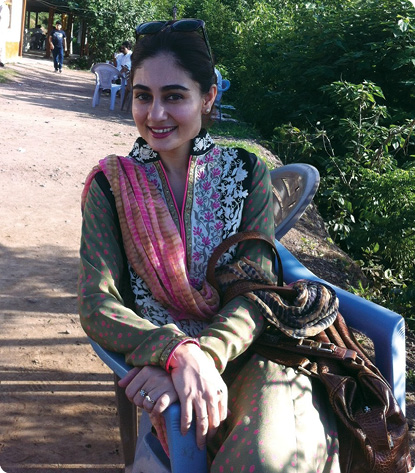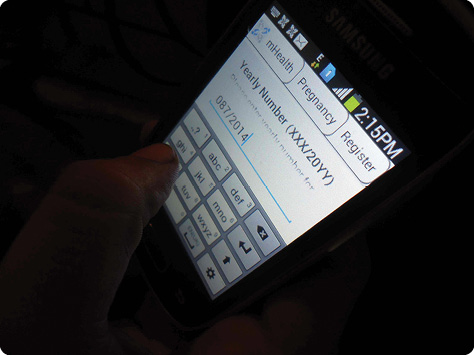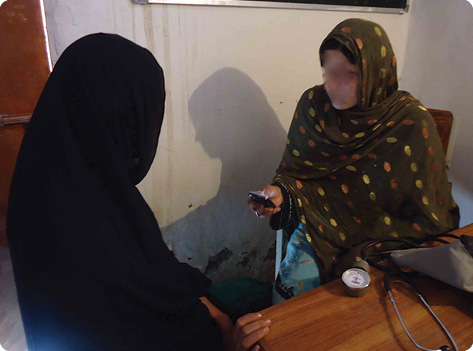The arid desert and mountainous region of Balochistan is the largest province of Pakistan, representing 44% of the land mass but with only 5% of the total population. Poverty remains widespread with the poorest households surviving on US$35 per month or fewer [1]. Located in the southwestern half of the country bordering Iran, it is the worst performing of Pakistan’s four provinces in most, if not all, of the targets set out in the United Nation’s Millennium Development Goals first defined in 2000. And while Balochistan’s progress is off track and below the national average in areas such as hunger and poverty, universal primary education, gender equality, and environmental sustainability, it is especially lagging in maternal health and child mortality [2].
The maternal mortality ratio is highest in the province of Balochistan at 785 per 100,000 live births compared to a national average of 276. Here, 81% of women deliver at home, and 72% of them are assisted by a traditional birth attendant. Under-five mortality is also the highest in Balochistan with 111 deaths per 1,000 live births, followed by Punjab (105 deaths per 1,000 live births), Sindh (93 deaths per 1,000 live births), and Khyber Pakhtunkhwa (70 deaths per 1,000 live births). There has been a 10% increase in under-five mortality in Balochistan during the last 20 years; in contrast, under-five mortality has decreased by 29% in Khyber Pakhtunkhwa, by 21% in Punjab, and by 12% in Sindh during the same period [3].
In a quest to address some of these daunting problems, our venture, Pakvista Technologies, partnered with Mercy Corps in the Saving Mother and Newborns in Communities (SMNC) program cofunded by the United States Agency for International Development and the Scottish government to develop a mobile health (mHealth) initiative to improve maternal and infant care. SMNC, Mercy Corps’ four-year project in three districts of Balochistan, seeks to improve maternal and newborn health status by 2016 with 450,000 direct beneficiaries. This opportunity challenged us to find suitable technological choices to support the project and also to think about the constraints around the adoption and sustainability of those choices. As technology solution providers in Pakistan for the last ten years, Pakvista Technologies is committed to finding indigenous solutions to the needs of local industry. This led us to take up some interesting custom software development and IT consultancy projects for national institutes as well as the private sector. These projects were a great learning experience that not only enriched our technical knowledge but also prepared us to undertake a complex and challenging project like the mHealth initiative in Balochistan.

After the abolition of Pakistan’s federal health ministry in 2011, the provincial government became the major provider of health services in Balochistan, as in Pakistan’s other provinces. In this system, community health workers and midwives play an important role in what is known as the National Maternal Newborn and Child Health (MNCH) program. This program, first created in 2007, tried to fill in the gaps in the maternal and child health domain by training and deploying 12,000 community midwives (CMWs) over a period of five years to provide skilled birth attendants for women in remote rural areas [5]. However, after completion of the five-year program in 2012, research revealed that many of the midwives failed to establish their practice in various parts of Pakistan, and projected improvements in maternal health were not realized. Key factors contributing to the failure of the MNCH initiative as outlined in [4] suggest that there was poor training, social norms that hindered the CMWs from performing their duties, and, most importantly, the failure of CMWs to establish self-sustaining clinics for their practice.
Our approach to finding the right technical solution to this problem was driven by two objectives: First, we wanted to build a solution that was easy to use for all the stakeholders, including the 90 CMWs supported under the SMNC. CMWs play a central role in Pakistan in managing delivery and providing a basic level of care that often makes the difference between life and death during delivery. Second, we wanted to make our solution scalable and sustainable for future reuse to potentially reach the nearly 12,000 CMWs from the MNCH program. In this context, we took advantage of open-source projects, including the MOTECH Suite by the Grameen Foundation [6] and CommCareHQ by Dimagi [7], to reuse existing tools as a foundation to build a model that can be replicated in other districts of Pakistan as well as any remote region of the world. This was a unique project as it included stakeholders from varied backgrounds. On the one hand, we had the well-informed development sector experts and government officials and, on the other hand, the CMWs from remote areas with limited exposure to technology. Finally, we had the illiterate and marginalized women from the target remote areas.
Our team designed and implemented a mobile technology solution with an objective to improve the demand for CMW services, thereby acting as an economic incentive for them to offer their services as well as provide real-time insight into the project indicators for all stakeholders. The proposed solution comprised 1) an Android-based mobile application to record client information using a set of data entry forms, 2) a cloud-hosted server application that would store the collected information as well as schedule the short-message service (SMS)-based reminders for each registered client at six-, eight-, and nine-month intervals, 3) behavior change communication (BCC) voice messages providing short messages tailored to the woman’s stage of pregnancy to improve MNCH practices supported in four local languages, and 4) an online dashboard representing the aggregated data in a graphical format to provide an overview of the key parameters of interest, detailed reports on individual data elements, and a custom reporting tool for key project indicators.
The adoption and use of the system by the CMWs was one of our biggest concerns. The selected CMWs had at least a basic tenth grade education, and preference was given to candidates who had previously owned a phone set. Using mobile phones to track CMW client data is an innovation in Pakistan, and we wanted to use a device that would provide a better and more intuitive user experience. Because smartphones are widely available, easy to use, and relatively low in cost, they were the ideal choice of technology. We decided to keep the mobile forms simple to begin with, making sure that all of the critical information was gathered through clear, unambiguous, but concise questions. The mobile forms were kept similar to the paper-based forms developed under the MNCH program. This would mean a shorter learning curve, higher acceptance, and more time available for learning to use smartphones to register and track clients. All of the forms were supported in English as well as the national language, Urdu. CMWs were involved periodically to give feedback on mobile application during development to make a product that CMWs would want to use. To improve the quality of the collected information, the data were validated as entered against permissible ranges. Skip logic was implemented wherever applicable to ask relevant questions based on the answers to the previous questions.

The technology adoption by the government of Balochistan’s Department of Health was also an important consideration since the ultimate success of the project rested in the adoption and expansion of the idea by the government. The health department officials saw value in the entire process of data collection, validation, and entry into an electronic system for analysis purposes. The dashboard and custom reporting tool were also useful in allowing them to see trends in maternal health indicators as a result of the adopted approaches. Department of Health officials attended training sessions and offered valuable feedback.
The low literacy rate among the women from the remote target area posed challenges in the delivery of BCC and reminder message content. CMWs were trained to register clients and record either their client’s mobile number, if available, or a household mobile number, if available. The SMS-based reminder was developed as ASCII character code (ASCII) rather than text so it would be understandable to all. The CMWs show this image to their clients at the time of registration in their clinics and tell them to come to the clinic for a checkup when the image is sent to their phone or the phone of any other person from their household. The visual reminder was designed to be a simple image that has been tested to appear in very basic phone sets without a scroll. Similarly, the localization of the message content to disseminate behavior change information was also important for people in remote areas to be able to relate to it and have an impact.

The mobile application was launched in June 2014, and so far, the response has been encouraging both in terms of application usage and client registrations with Quetta, the capital of Balochistan, leading with 204 clients registered (Figure 3). Training sessions were conducted in Quetta with master trainers from Mercy Corps, Department of Health officials, and a subset of CMWs. During the training, most of the CMWs did not have a problem in understanding the mobile forms and their flow. The skip logic, where relevant questions were asked based on the answers to the previous questions, was intuitive, and most could anticipate the flow. According to the survey conducted during the training, the CMWs preferred the mobile application because it was easier for them to use. Case tracking was easier and less cumbersome than paper-based files for each client, and some even found the idea of carrying one fewer thing around as a motivation for its use. Of the many CMWs present during the training, there were a few who were not as enthusiastic in using the application as the rest of the group. These were the same CMWs who found it challenging to handle the smartphone. We believe that by expanding the training on smartphone usage, these CMWs would have better smartphone operating skills and, consequently, see the value in its suggested use.
The videos prepared for the training sessions were extremely well received. Our approach was to prepare short videos of no more than three minutes focusing on one aspect of the application usage and some motivational message. In the future, these videos can be saved efficiently on the phone so that they can be viewed repeatedly as a refresher of important concepts rather than long training session videos that are not available in the field. Data from the field are being monitored closely to ensure that the application is being used effectively and that CMWs are following the procedural protocols. We are also monitoring how many clients are registering their phone numbers for SMS and BCC, as this will indicate whether our strategy is effective at increasing the demand for CMW services.
The last couple of years have been extremely formative in defining a vision for our team to apply our technical skills and entrepreneurial experience to social development causes, especially those that disproportionately affect women in Pakistan. There are still many things to learn and possibilities to be explored. As a team, we are already researching ideas to address issues in health and education, which are desperately needed in Pakistan, the sixth most populous country in the world with nearly 180 million people. Fortunately, the advent of third- and fourth-generation cellular networks in Pakistan, better coverage, and improved bandwidth will make many novel ideas cost-effective. We look at the mHealth initiative as a first step toward making positive contributions to social issues, especially those affecting the marginalized communities in Pakistan.
References
- World Health Organization. (2013). Country cooperation strategy for WHO and Pakistan 2011–2017. [Online].
- UNDP Pakistan 2013: Pakistan MDG Status 2012. [Online].
- National Institute of Population Studies (NIPS) Pakistan 2014: Pakistan Demographic and Health Survey 2012-2013. [Online].
- Z. Mumtaz, A. Cutherell, and A. Bhatti. (2014). Saving mothers and newborns in communities: Strengthening community midwives to provide high quality essential newborn and maternal care in Baluchistan, Pakistan in a financially sustainable manner. [Online].
- A. Y. Alam, “Health equity, quality of care and community-based approaches are key to maternal and child survival in Pakistan,” J. Pak. Med. Assoc., vol. 61, no. 1, pp. 1–12, Jan. 2011.
- Motech Suite. [Online].
- Dimagi. [Online].



